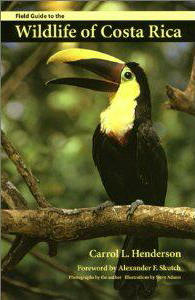Braulio Carrillo National Park. We hiked up and down this place for several hours one morning without seeing many birds. I, however, snapped lots of pix of plants and flowers. It used to be one of the major birding areas in Costa Rica however there's been a lot of road building (widening a major highway) and subsequent building around the park borders. It's not so birdy any more.
A glance at the canopy
Lianas, more lianas.....
Passion Flower Passiflora vitifolia. So pretty in the midst of the green, green, and more green of the tropical forest.
Heliconias are among my favourite tropical plants. This one is Heliconia longa.
Impatiens grow wild here, one of the many types of ground cover we, here in North America, value as annuals in our yards and planter boxes. This is Impatiens walleriana, at the entrance to the park.
At the edge of the parking area, a Morning Glory (Ipomoea spp.) peeks out from under a large dead leaf.
A Cycad. This is a female cone, of the genus Zamia, possibly Zamia fairchildiana
A primary forest giant
 My reference: A Guide to Tropical Plants of Costa Rica, written by Willow Zuchowski and photographs by Turid Forsyth. I got my copy at Monte Verde during my first visit to CR.
My reference: A Guide to Tropical Plants of Costa Rica, written by Willow Zuchowski and photographs by Turid Forsyth. I got my copy at Monte Verde during my first visit to CR.
As always, click on the photos to enlarge, if you want to.
A glance at the canopy
At the forest floor
Lianas, more lianas.....
Passion Flower Passiflora vitifolia. So pretty in the midst of the green, green, and more green of the tropical forest.
Heliconias are among my favourite tropical plants. This one is Heliconia longa.
Impatiens grow wild here, one of the many types of ground cover we, here in North America, value as annuals in our yards and planter boxes. This is Impatiens walleriana, at the entrance to the park.
At the edge of the parking area, a Morning Glory (Ipomoea spp.) peeks out from under a large dead leaf.
A Cycad. This is a female cone, of the genus Zamia, possibly Zamia fairchildiana
A primary forest giant
 My reference: A Guide to Tropical Plants of Costa Rica, written by Willow Zuchowski and photographs by Turid Forsyth. I got my copy at Monte Verde during my first visit to CR.
My reference: A Guide to Tropical Plants of Costa Rica, written by Willow Zuchowski and photographs by Turid Forsyth. I got my copy at Monte Verde during my first visit to CR. This is another must-get book for nature lovers visiting Costa Rica. I tend to collect field guides, in general. This is one of the best I have. The author not only describes the plants (in terms the rest of us understand), she also talks about the importance of given plants to the culture and economics of the country and how they are used. It's a very interesting book.
The photographs are beautiful.
As always, click on the photos to enlarge, if you want to.






















 Ice crystals in the atmosphere are hexagonally shaped. Crystals forming most optical phenomena in the air are typically hexagonal rods, shaped like pencils, or flat, hexagonal plate patterns, like microscopic stop signs or dinner plates. When plate-shaped ice crystals fall unimpaired, drag forces automatically orient them horizontally so that their larger, flat surface parallels the earth like a large maple leaf drifting down from a tree.
Ice crystals in the atmosphere are hexagonally shaped. Crystals forming most optical phenomena in the air are typically hexagonal rods, shaped like pencils, or flat, hexagonal plate patterns, like microscopic stop signs or dinner plates. When plate-shaped ice crystals fall unimpaired, drag forces automatically orient them horizontally so that their larger, flat surface parallels the earth like a large maple leaf drifting down from a tree.






























